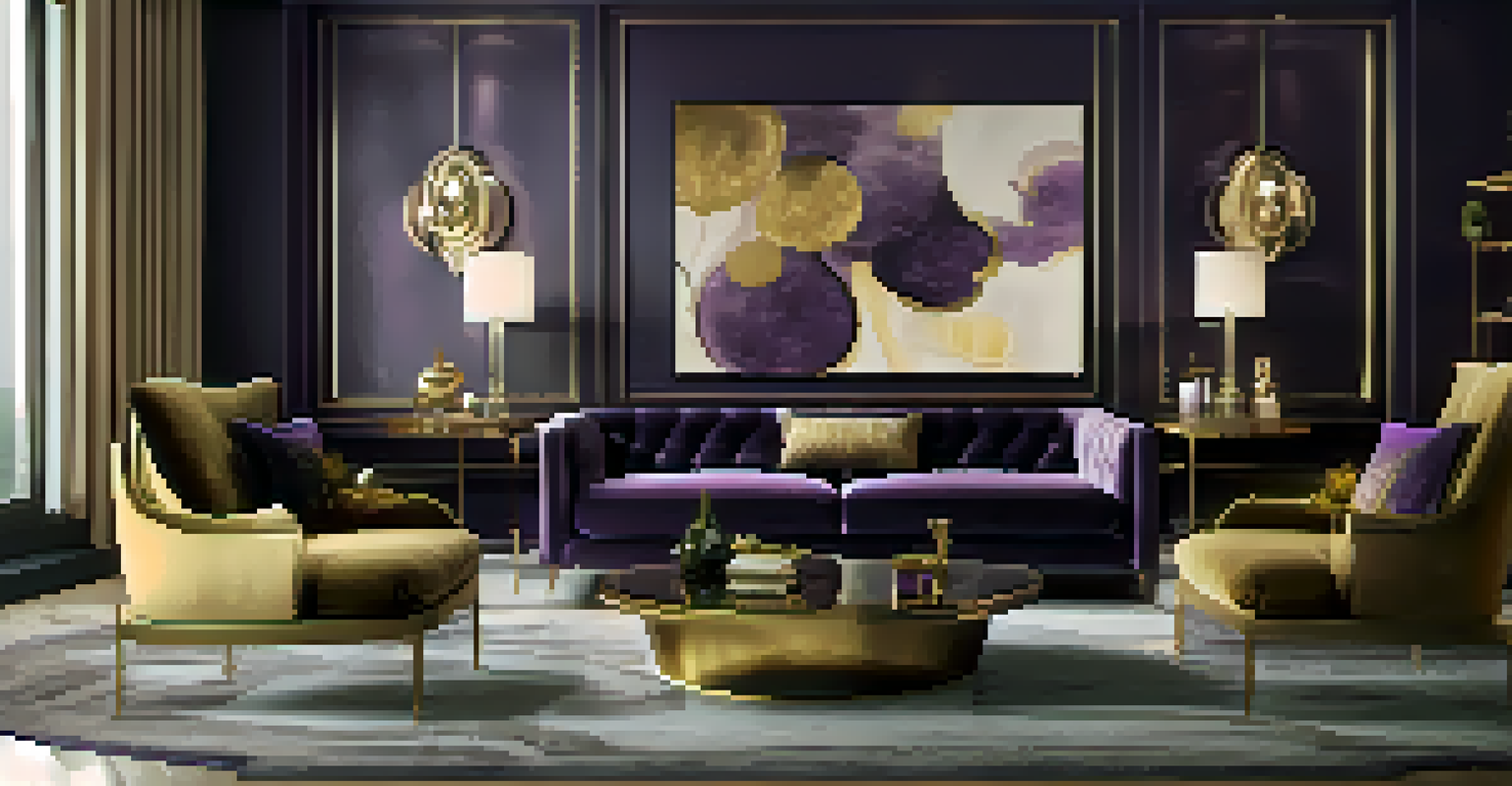Symbolism in Color: Conveying Themes Through Hues

Understanding Color Symbolism in Everyday Life
Color symbolism is all around us, from the clothes we wear to the decor in our homes. Each color evokes different feelings and associations, influencing our emotions and decisions. For example, red often signifies passion or danger, while blue tends to evoke calmness and trust. Understanding these associations can help us communicate more effectively in our personal and professional lives.
Colors are the smiles of nature.
Consider how businesses use color in their branding. A fast-food chain might use bright colors like yellow and red to stimulate appetite and energy, while a luxury brand may opt for black or gold to convey sophistication and exclusivity. This strategic use of color not only attracts customers but also helps convey the brand's values and mission.
In art and literature, color symbolism deepens the narrative. An artist might use a splash of green to symbolize growth or rebirth, while a writer may choose dark hues to convey despair. By becoming aware of these nuances, we can appreciate the layers of meaning behind what we see and read.
The Psychological Impact of Colors
Colors don't just look pretty; they can profoundly affect our mood and mindset. Studies show that certain colors can increase productivity, reduce stress, and even influence decision-making. For instance, blue light is known to enhance focus, making it a popular choice in workspaces, while soft greens can create a serene environment.

Think about how you feel when you enter a room painted in vibrant yellow compared to one shaded in muted gray. The former might uplift your spirits and energize you, while the latter could evoke feelings of sadness or lethargy. This psychological impact explains why color choice is so critical in interior design and marketing.
Colors Influence Emotions and Decisions
Color symbolism affects our feelings and choices, impacting everything from branding to personal interactions.
By choosing colors that resonate with our desired emotional outcomes, we can create spaces and experiences that align with our intentions. Whether it’s a calming blue for a bedroom or an invigorating orange for a gym, understanding the psychological effects of colors can lead to more harmonious environments.
Cultural Variations in Color Meaning
Color symbolism isn't universal; it varies widely across different cultures. For example, while white is often associated with purity and weddings in Western cultures, it can symbolize mourning in some Eastern traditions. This cultural context plays a significant role in how we interpret colors in various settings.
Color is the keyboard, the eyes are the harmonies, the soul is the piano with many strings.
When marketing products or designing content for a global audience, being mindful of these cultural differences is crucial. A color that represents trust in one culture might evoke negative feelings in another. Understanding these nuances helps brands avoid miscommunication and resonates more deeply with diverse audiences.
As we navigate our increasingly globalized world, appreciating these cultural variations in color symbolism can foster empathy and inclusivity. It encourages us to celebrate diversity and remain sensitive to the meanings that colors hold in different communities.
Symbolism of Primary Colors: Red, Blue, and Yellow
Primary colors—red, blue, and yellow—hold powerful symbolic meanings that are often foundational in color theory. Red typically embodies energy, passion, and action, making it a color associated with love and excitement. It’s no surprise that it’s a popular choice for marketing promotions.
Blue, on the other hand, represents tranquility, reliability, and trust. This is why many corporate logos and social media platforms use blue, as it invokes a sense of security and calmness. It's a color that can soothe and stabilize, making it a favorite in many professional settings.
Cultural Context Shapes Color Meaning
Understanding cultural variations in color symbolism is essential for effective communication and marketing.
Yellow is the color of optimism, creativity, and happiness. It can energize a space and inspire creativity, which is why it’s often used in educational environments. Each primary color, with its unique symbolism, lays the groundwork for creating a rich tapestry of meaning when combined with secondary colors.
The Role of Secondary and Tertiary Colors
Once we understand primary colors, we can explore secondary and tertiary colors, which blend the meanings of their primary counterparts. For example, green, a secondary color created by combining blue and yellow, symbolizes growth, renewal, and nature. It’s a color often used in environmental campaigns to evoke feelings of sustainability.
Similarly, purple, a blend of red and blue, conveys luxury, creativity, and spirituality. Its historical ties to royalty make it a powerful choice in branding for high-end products. By mixing colors, we can derive new meanings that enhance emotional connections.
Tertiary colors, formed by mixing primary and secondary colors, further expand this palette of symbolism. They can create subtle variations in meaning and tone, offering more nuanced options for artistic expression, design, and communication.
Color Symbolism in Art and Literature
Artists and writers have long used color symbolism to deepen their narratives and enhance emotional resonance. In paintings, the use of color can evoke specific moods or highlight certain themes. For instance, Vincent van Gogh’s use of vibrant yellows in 'The Sunflowers' conveys warmth and happiness, while darker tones in his self-portraits reflect inner turmoil.
In literature, authors often employ color imagery to symbolize themes or character emotions. In F. Scott Fitzgerald’s 'The Great Gatsby,' the green light symbolizes Gatsby's hope and dreams. Such use of color imagery enriches the text and invites readers to explore deeper meanings.
Practical Uses of Color in Design
Incorporating color symbolism in design can enhance environments and strengthen brand identity.
Understanding these artistic choices allows us to appreciate the layers of meaning that colors can convey. Whether through brush strokes or words, color remains a powerful tool for communication in art and literature.
Practical Applications of Color Symbolism
Harnessing the power of color symbolism can enhance various aspects of life, from design to personal branding. When creating a logo or marketing materials, consider the emotions and messages that different colors evoke. Aligning your color choices with your brand's mission can create a more cohesive identity.
In interior design, understanding color symbolism can help create spaces that reflect desired atmospheres. A calming blue bedroom can promote relaxation, while a vibrant orange kitchen can inspire creativity and energy. Thoughtful color choices contribute significantly to how we experience our environments.

Even in daily life, being mindful of color symbolism can enhance our interactions. Choosing clothing colors that resonate with how we want to feel can boost our confidence and presence. By integrating color awareness into our lives, we can communicate more effectively and create more meaningful connections.